












YUTONG WANG Interactive Art + Design Portfolio Selected Works 2019 - 2022
Yutong Wang
Born in 2001 in Wuhan, China, Yutong Wang (they/them) are a queer multimedia artist and designer based in Brooklyn, New York.
Yutong are currently pursuing a Bachelor of Fine Arts degree at NYU Tisch School of the Arts, where they double major in Interactive Media Arts and Art History.

Yutong are constantly exploring unconventional interactions with human body through their constantly-evolving works, which include immersive experiences, interactive installations, audiovisual performances, and creative coding projects.
Their works have been showcased at the NYU Interactive Telecommunications Program, theBlanc Gallery, Wonderville, and Elevator Shanghai.
CONTENT II 01 Space Dementia Spatial Interactive Immersive Experience 02 Breathing Mirror Interactive Installation 03 CIRCUIT Motion-tracking Video Sculpture 04 Mouth Stitching Audiovisual Live Performance 05 Odyssey Interactive Web-based Data Visualization 06 Kitchen Genie Chatbot Interface Design 15 12 07 01 23 19
Space Dementia
Interactive Immersive Experience
Visualizing the Homonymic Fictional Mental Disorder
Type Individual Project
Date December 2019
Instructors Sarah Rothberg + Mimi Onuoha
Keywords Spatial Interaction + Animation + Motion Tracking
Tools JavaScript ( p5.js ML5.js ) + Adobe After Effects + Adobe Audition + Adobe Photoshop

01 SPACE DEMENTIA 1
01 Project Description
This project is a site-specific interactive immersive experience visualizing Space Dementia, a hypothetical mental disorder that causes psychological instability to astronauts isolated from the human society in the outer space.
Consisting of an animation and an embedded interaction design, this project breaks the fourth wall in 2D visual art by tracking the motions of the audience and transforming these data into audio feedback. It brings interactivity into convential ways of viewing moving images.
03 Approach and Tools
Projection on wall
Animation
Visual Adobe Photoshop
Adobe After Effects
Zoom H6 recorder Microphone +
Audio
Interactive immersive experience
Interaction design
Connected to webcam
Ran by laptop
02 Key Concept 04 Project Flowchart
In Space Dementia, the audience is both a viewer and a player.
View passively receive information
Audience enters the space and project begins
Transform the role of the audience
Animation part I
Motion tracking
Adobe Audition p5.js
ML5.js
Audio feedback p5.js
Watch animation
Project ends and audience leaves the space
Animation part II
Animation part III
Audience’s motions are tracked by webcam
Interaction Design Participate actively generate data
Motion data transformed into audio feedback
See and hear instruction to interaction
Interactive part ends
Follow instruction and interact
01 SPACE DEMENTIA
2
Development Process I - Animation
Visual Part
Storyboard
I first sketched a storyboard for 9 major scenes in this 3-part animation:

Element Preparation
The elements used in the scenes were from royalty-free pictures found online. In order to use them, I removed their backgrounds and recolored them in Adobe Photoshop:
Animation
Cutting out elements in Adobe Photoshop, I then animated them in Adobe After Effects:






Animation Outcome
The final outcome is a dubbed digial collage animation in surreslitic style and it is 4 minutes and 29 seconds long.




Here are some stills:
Audio Part


Script
The script was written as the diary of an astronaut who was trapped inside his space craft and lost connection to the Earth. The 3 parts of the animation refers to 3 pieces of diary from 3 incoherent dates, during which the astronaut becomes more and more mentally unstable.


In the Part II of the animation, the astronaut mentions his condition of auditory hallucination and gives instructions that ask the audience to move their arms for motion tracking and spatial interaction:

“I also find this subtle harmony with the space, that I can hear the sound of the space coming through my ears into my mind. If you are listening, I want you to come closer. Come and stand in the center. Stretch your arms like you are about to embrace someone. Do you hear it? The sound of the universe? Stretch your arms so that you can hear different sounds, like you are playing an intangible harp — so mesmerizing. Now raise your arms high. Do you feel the change? The rising amplitude is waking everything in the world.”
Record, Edit, and AV Sync
The voiceover was recorded using Zoom H6 recorder and edited in Adobe Audition:
The audio part was synced to the visual part using Adobe Premier.

01 SPACE DEMENTIA 05
3
Part Scene 1 Part Scene 2 Part I Scene 3 Part II Scene 1 Part II Scene 2 Part II Scene 3 Part II Scene 4 Part III Scene 1 Part III Scene 2
06 Development Process II - Interaction Design
This interactive part embedded in the Part II of the animation is for re-creating the auditory hallucination experienced by the astronaut. As the audience move their arms as the animation instructs, they will hear music that responds to their movements. I used p5.js and PoseNet in the ML5.js library, a pre-trained machine learning model for Real-time Human Pose Estimation.


Motion Tracking
Data Detection
PoseNet processes the image of human into a skeleton of 17 key points and tracks their coordinates. I chose to track the movements of the two wrists of the audience, the result of moving hands and arms, since astronauts move in a weightless environment with this gesture.
Data Process
PoseNet only generates x and y coordinates of tracked parts, so additional code is needed for calculating the distance between the left and right wrists.



the Distance Between Wrists
The distance between the two wrists controls the midi value of the audio: The y coordinate of the two wrists controls the amplitute of the audio:

Audio Feedback Testing

01 SPACE DEMENTIA
4
Position of
Input x,
Output
PoseNet
wrists
y coordinates
PoseNet part selection in p5.js
Calculate
07 Development Process III - Spatial Layout
This project is installed inside a room with three blank walls.


01 SPACE DEMENTIA
08 Project Outcome
This project was not set up as large as the ideal spatial layout has planned due to limitations in space. However, it was shown to and tested by 40 people in two in-class critiques. It received positive feedback, such as “It is a very creative and engaging way of storytelling.”


In-Class Screening

In-Class Interaction Testing

01 SPACE DEMENTIA
6
Breathing Mirror
Interactive Installation for Visualizing the Meditation Process
Selected for NYU ITP | IMA Winter Show 2022 and Wonderville Winter Show

Type Individual Project
Date October 2022
Instructor Chika Iijima
Keywords Interaction Design + Projection Mapping
Tools Touch Designer + MadMapper + MUSE 2
02 BREATHING MIRROR
01 Project Description
Breathing Mirror is an interactive installation that substantializes a meditation process. The image of the player is connected to their brainwave through MUSE 2 and only a peaceful mind will return the artificially-processed, disturbing image into the true face of oneself.

02 Project Flowchart
03 Development Process I - Visual Effect

The visual effect was made in Touch Designer:
Brainwave Detection
The intensity of the visuals is controlled by the player’s brain activity, which is detected by MUSE 2, a brain sensing head band.

Person Detection
I programmed the installation to activate automatically when a player is detected by the webcam.

To have this effect, I included a person-detecting function using the Blob Track TOP module in Touch Designer. Visual effects decrease when brain is more relaxed
I used Mind Monitor, a mobile app for receiving the brainwave data from MUSE 2. This app generates an electroencephalography that splits the brain activity into 5 waves.

Among them, the Alpha wave represents the level of relaxation and meditation, which would be used by me in controlling the visuals in Touch Designer.
I used an OCS In CHOP module to receive data from Mind Monitor to Touch Designer. The value of the Alpha wave is then exported to TOPs that control the intensity of visual effects.


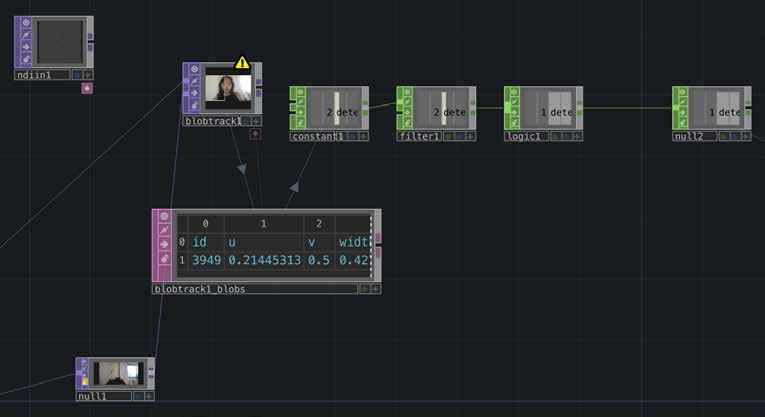

The more relaxed the brain, the higher the higher the Alpha wave value, the lower of the intensity of visual effects:

02 BREATHING MIRROR
8
Elliptical Projection Board Touch Designer MUSE 2 Put on MUSE 2 to interact Player Project visuals on to the projection board Projector Webcam MadMapper Detect player’s brainwave Capture player’s image Use brainwave data to process image Map the projection onto the circular installation Visuals activated when a person present Visuals stopped when no person present
Visual effects increase when brain is less relaxed
Front, Side, and Top
02 BREATHING MIRROR 9
04 Development Process II - Spatial Layout
Views Wireless Projector Webcam Elliptical Projection Board Indication for Standing Position for the Viewer Laptop Laptop Power Cable Webcam Cable 40 in” 30 in” Table MUSE 2 Wireless Projector Webcam Elliptical Projection Board Laptop MUSE 2 Webcam Cable Table Indication for Standing Position for the Viewer Simplized Interaction Demo Graph Front View Side View Top View MUSE 2 Wireless Projector Laptop Webcam Cable Elliptical Projection Board Webcam Table Laptop Power Cable MUSE 2 Indication for Standing Position for the Viewer
Development Process III - Prototype

Prototype Making

Before connecting the installation to MUSE 2, I created a prototype using corrugated cardboard for a test on the projection mapping of the visual effect.
Projection Mapping

And I projected the visuals onto the installation by connecting Touch Designer to MadMapper.

06 Development Process IV - Physical Setup
Fabrication
I used six pieces of plywood sheet boards and laser cutted them into a ellipse. Then I painted them in white for a better projection effect.

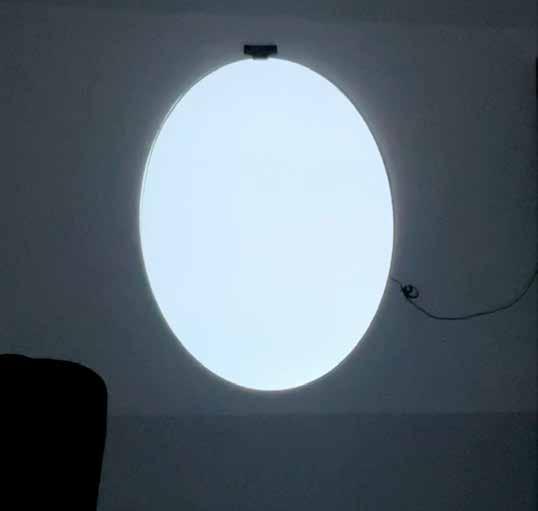



Prototype Testing
Setup
The plywood sheet boards are installed onto the wall piece by piece.
Here is the setup for Breathing Mirror in the NYU ITP | IMA Winter Show 2022:


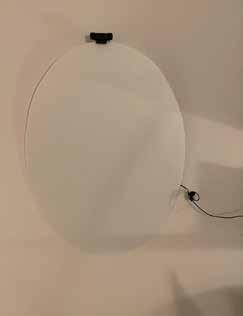
02 BREATHING MIRROR
30 in 40 in 12 in 22 in
Cutting Plan Laser Cutting Coloring
Breathing Mirror was exhibited in two shows:



NYU ITP | IMA Winter Show 2022
370 Jay Street, Brooklyn, NY 11201 December 18th - 19th, 2022

02 BREATHING MIRROR 11
07 Project Outcome
CIRCUIT
Motion-Tracking Video Sculpture


Selected for SCRIPTING, a juried group exhibition at TheBLANC Art Space
Type Duo Project
Collaborator Yulin Fu
Personal Roles Concept Developer + Visual Effect Artist
Date June 2022
Keywords Interactive Art + Motion Tracking
Tools Touch Designer + CRT TV
03 CIRCUIT 12
01 Project Description
The image of oneself subtly combines tangibility and invisibility. One can touch it and feel it but can never see it without the representation in other media. After the invention of electronic devices, images made up of electronic circuits have been displayed on flat screens everywhere for decades. But the image is still intangible, existing only as a form of energy.

To further emphasize and exaggerate how images distort and misrepresent the reality and the conceptions of the self, CIRCUIT captures the energy that enables the image and gives it a mesmerizing twist.
02 Project Flowchart

03 Development Process
The circuit-bending visual effect was made in Touch Designer:


“Ominous Television” Effect


Using Blob Track TOP module in Touch Designer, this effect can be trigerred by person detection and is automatically turned off if no person is in front of the camera. This interaction design was inspired by Ominous Television, a horror film trope of a TV suddenly becoming malfunctional. By imitating this effect, CIRCUIT symbolizes the invisible ubiquity of electronic devices in our life.

04 Testing
03 CIRCUIT
13
Touch Designer HDMI Cable HDMI to AV Converter Webcam Connected to Touch Designer Detect the image of the viewer Touch Designer Process the image of the viewer CRT TV Display processed image from Touch Designer
Not
Triggered
triggered When not triggered, the TV displays normal images captured by the webcam
When
triggered, the TV displays images with circuit-bending effects
05 Project Outcome
CIRCUIT was exhibited in a group exhibition:



SCRIPTING

theBLANC Art Space, New York City, NY 10016
June 25th - July 1st, 2022

03 CIRCUIT 14
“This video sculpture is a mirror alternating between reality and matrixesque screen distortions.”
— Art Critique by Morgen Mueller and Elvin Ou, Juries of SCRIPTING
Mouth Stitching
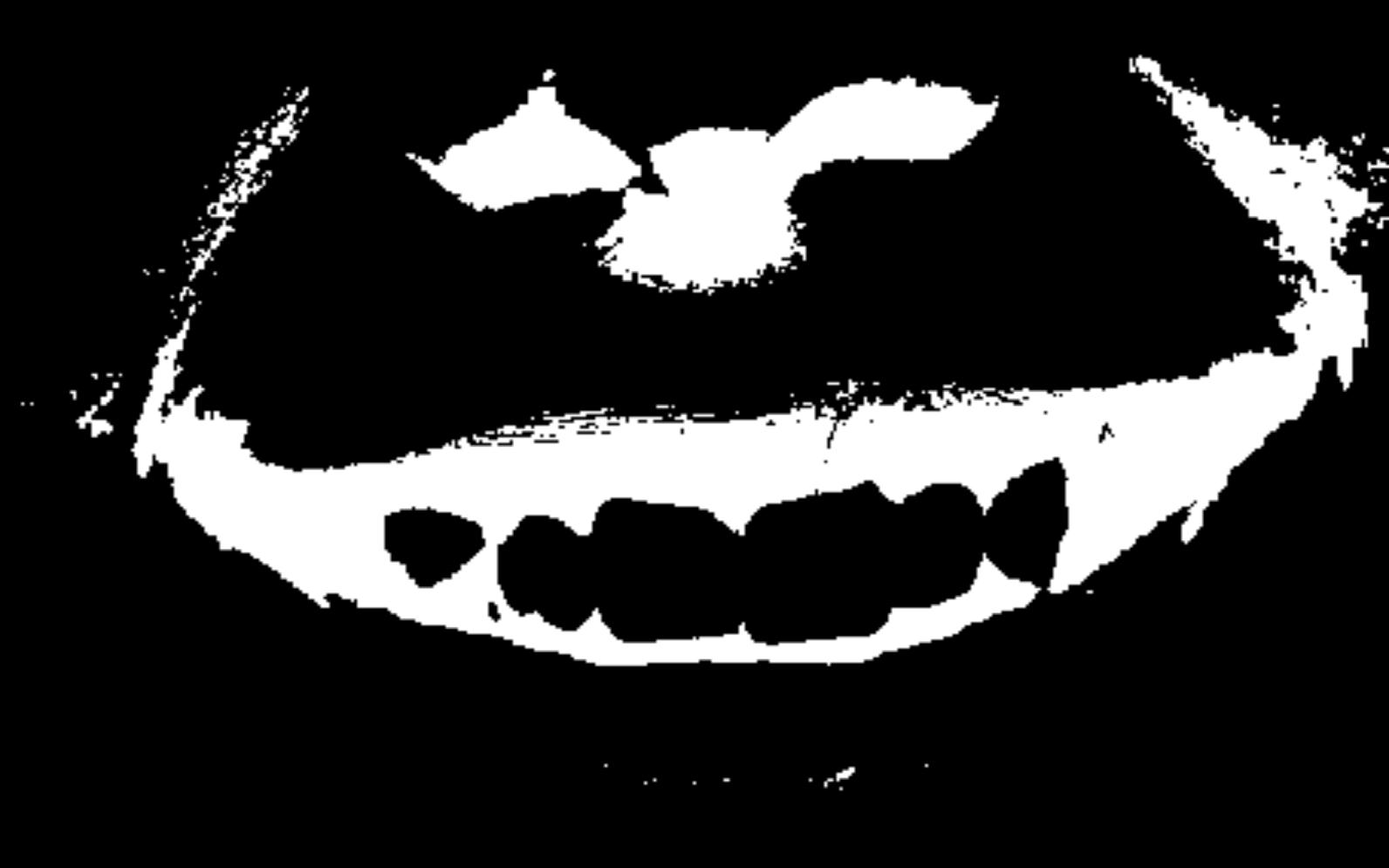
Audiovisual Live Performance
Selected for NYU ITP | IMA Spring Show 2022
Type Duo Project
Collaborator Yulin Fu
Personal Roles Concept Developer + Visual Artist + VJ
Date June 2022
Keywords Audiovisual Performance + Experimental Sound Design
Tools MAX / MSP + Ableton Live
04 MOUTH STITCHING 15
01 Project Description
Mouth Stitching is an audiovisual live performance collaborated by Yutong Wang and Yulin Fu.

Using MAX/MSP and Ableton, the two artists created dynamic visuals responsive to the rhythmic audio part.




The audio of Mouth Stitching is influenced by Acid House music from the 80s Techno music. Yulin recreated the sound of the bass synthesizer Roland TB-303, which was released in 1981, adding a retro quality to the rhythmic Techno beats. Following a well-designed composition, the audio progresses with modulations of frequencies and shifts in layers of melodies that trigger synchronized changes in the visual part of the performance.

The visual style of this performance is a combination of figuration and abstraction. Using Jitter in MAX / MSP, Yutong processed pre-recorded videos of Yulin’s face into black and white silhouettes and generate white cross-hatching lines to map out these silhouettes. The alienated faces are deformed, rotated, or reversed in black and white along with the changes in the tempo and melodies of the audio counterpart. The aesthetic subtly mixes minimalistic colors with minimalist line art, and it is partially inspired by ad/ab Atom, an audiovisual installation by Japanese artist Ryoichi Kurokawa.



02 Visual Inspiration
03 Development Process I - Visual and Audio Design
04 MOUTH STITCHING
16
The visual for this performance was made in MAX / MSP: The audio was made in Ableton Live:
The visual and audio were mapped and controlled by Novation Launch Control:
Ryoichi Kurokawa ad / ab Atom
Max Patch Max Patch in Presentation Mode
Visual Effect - Pixelated Visual Effect - Lines
Development Process II - Spatial Layout



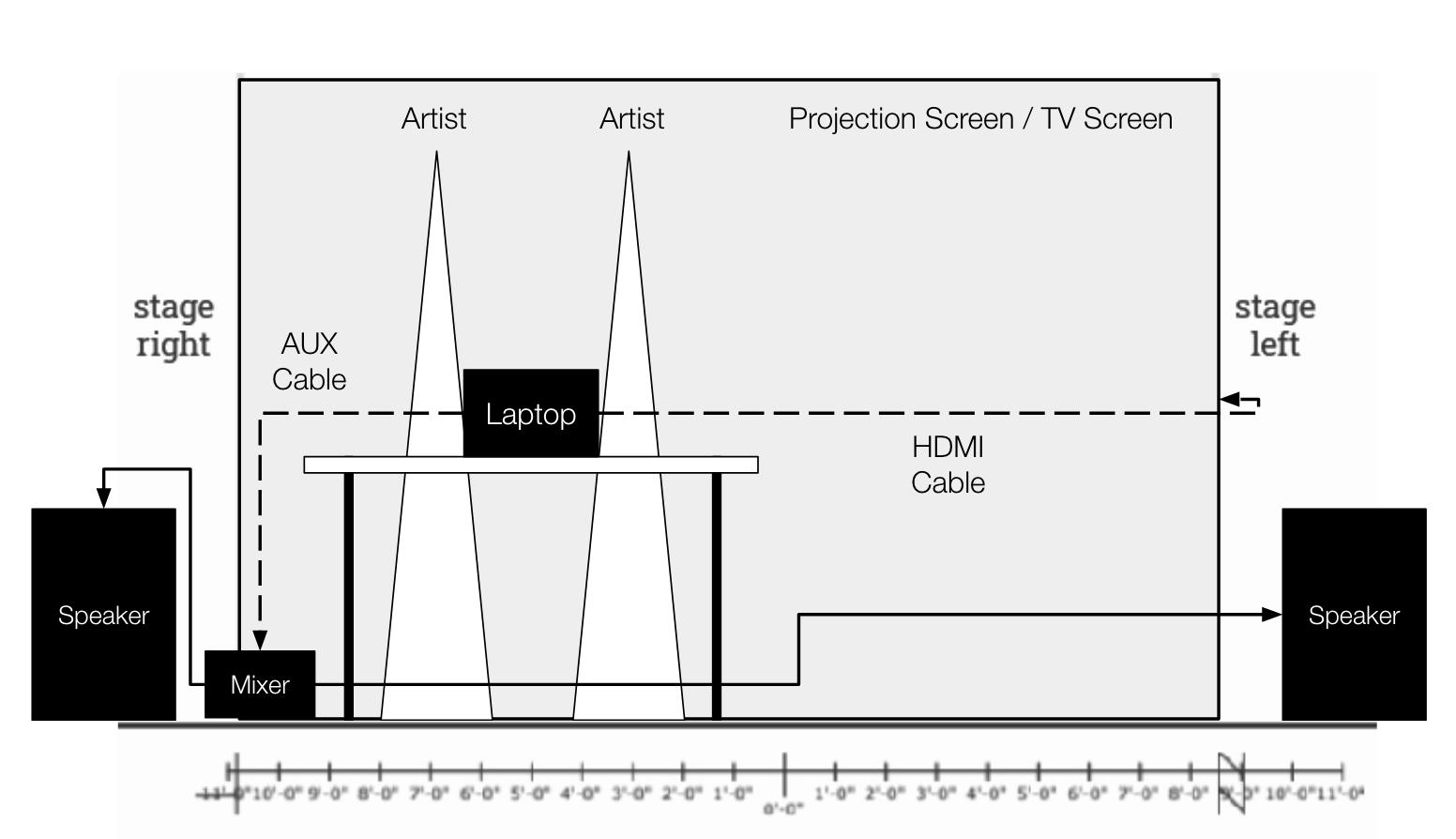
04 MOUTH STITCHING 04
17
Performance Space Floor Plan
Schematic
Elevation Plan
Performance Plan
05 Project Outcome
This 9-minute long performance was publically performed in two shows:
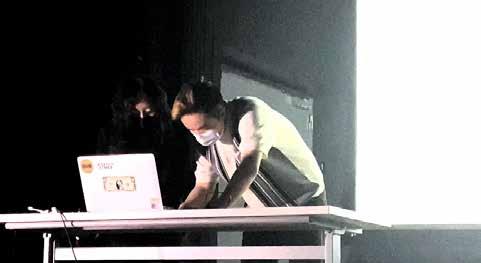

Designing Interfaces for Live Performance Live Final Show
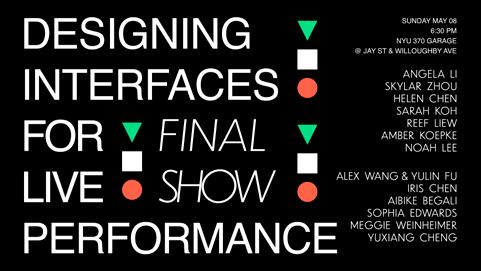
370 Jay Street, Brooklyn, NY 11201
May 8th, 2022
NYU ITP | IMA Spring Show 2022
370
May 16th - 17th, 2022
04 MOUTH STITCHING 18
Poster Design by Yutong Wang
Jay Street, Brooklyn, NY 11201
ODYSSEY
Interactive Web-Based Data

Visualization of the Space Age
Type Individual Project
Date May 2021
Instructor Leon Eckert
Keywords Data Visualization + Interactive Website Design
Tools JavaScript ( d3.js ) + HTML + CSS
05 ODYSSEY 1 19
01 Project Description
As a member of Generation Z, I was raised up in a world with a long-existing obsession of space exploration. Seeing countless news on space technology and launches of space missions, I have always wondered the following questions: What is the reason behind this obsession? What is the origin of this obsession? How has it marked the development of mankind?
These questions drove me to research on the Space Age, an age of space explorations and technology starting from 1957. I have searched for data about significant events and space missions during the Space Age and created Odyssey, a web-based interactive data visualization.
02 Approach
Data Collection
The input data came from five datasets:
1. UCS Satellite Database
2. Chronology of Space Launches from Gunter's Space Page
3. Launch Sites from Gunter's Space Page
4. Chronology of Significant Events in Space from Wikipedia
5. GeoJSON Data for Countries in the World
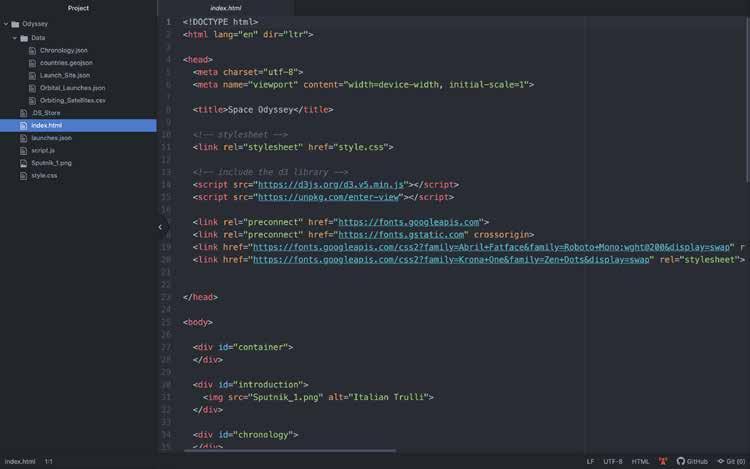

Coding


The first two datasets were downloaded from the web as excel forms, which were converted by me into csv and json files for using in my coding process. The third and fourth datasets were scraped from web pages in json files by me using ParseHub, a web scraper. The last one was received from Prof. Leon Eckert as a class material.
This data visualization was coded in JavaScript with the use of d3.js library, HTML, and CSS:
05 ODYSSEY
20
JavaScript: Programmed Interactions
CSS: Designed Website Layout HTML: Coded Website Content
JavaScript: Programmed Interactions
Visual Inspirations
I wanted this project to have a clean, minimal, and informative design, so I used these following cover arts and website as both style and color references:
04 Design System


Based on my references, I created a design system: Color Typography - Gotham
Primary Colors

05 ODYSSEY 03
21
Frank Bretschneider Rhythm Ø & Panasonic SähköThe Movie Soundtrack EP Alva Noto alvanoto.com
#000000 #2A49C9 #FFFFFF #C4D545 Heading 1 Weight Book Size 150 px Heading 2 Body 1
Book Size 48 px Weight Book Size 20 px Body 2 Weight Book Size 18 px Weight Book Size 16 px Body 3
Weight
#F6222E
Secondary Colors
Project Outcome
The outcome is a eight-section interactive data visualization. These sections vertically aligned and users to need scroll down to view them all. In interactive sections, there are instructions for how to interact on the left. Here are six selected sections:















05 ODYSSEY 05
22
Introduction
Force Graph of Orbital Launch Sites Bar Chart of Orbital Launches Per Year
Scrollable Timeline of Significant Technological Events Scrollable Visualization of Orbital and Suborbital Spaceflights
Force Graph of Operational Satellites
Kitchen Genie
User Experience and Conversation
Design for a Cooking-Assisting Chatbot

Type Individual Project
Date November 2021
Instructors Regine Gilbert
Keywords User Experience Research + Conversation Design + Chatbot
Tools Figma + Engati
06 KITCHEN GENIE 23
01 Project Description
Kitchen Genie is a cooking-assisting chatbot targeting college students who cook. I conducted user research for clarifying the pain points and needs of the target users and focused on conversation design for a chatbot in reponse to the research outcomes.
02 Inspiration
After living alone in my junior year, I started spending extra time on cooking, especially on looking for recipes online, which took a lot of my limited free time.
While talking to my friends and classmates, I found that similar problem exists among them and came up with the idea for creating a cooking-assisting chatbot.
03 Design References
Instacart Ideas & Guides
Curated recipes and meals on the website of Instacart
04 Project Content Overview
Alexa Shopping List Skill
Voice user interface for adding and sorting items in the Amazon shopping list
05 User Research
Qualitative Research: Interview
I interviewed four college students about their cooking habits and preferences for a cooking-assisting chatbot:
Frank
How often do you cook?
“Everyday.”
Do you need to look at recipes for cooking?
“I have a general recipe and I use the same ingredients. But sometimes I will look up recipes for substituting ingredients.”
How many people do you cook for?
“Usually one, but sometimes I cook for two people.”
Do you often cook new dishes that you have not made before?
“Recently it is quite frequently.”
How do you look for recipes?
“Ask a friend or a family member.”
Male 22
What tone do you expect from a cooking-assisting chatbot?
“Light-hearted and casual.”
What features do you expect in a cooking-assisting chatbot?
“Recipes and how to cook them. Recommendation system is not always accurate, so it is not on my priority list. But I am interested in how this function works.”
Kaitlyn Female 20
How often do you cook?
“I never cook at school because I am currently living in the dorm and it takes too much effort for cooking. But I cook on occasions like Thanksgiving or Christmas.”
Do you need to look at recipes for cooking?
“Yes.”
How many people do you cook for?
“Five people.”
Do you often cook new dishes that you have not made before?
“Yes.”
How do you look for recipes?
“Pinterest and blogs online.”
What tone do you expect from a cooking-assisting chatbot?
“Excited and cheerful”
What features do you expect in a cooking-assisting chatbot?
“I have not cooked for a long time, so I do not have many specific special answers. Maybe just recipes? And it would be cool if the chatbot can tell me when to add the next ingredient and when to turn off the heat.”
06 KITCHEN GENIE 24
Journey
Flow Script Design Prototype
Research
Storyboard
User
User
User
User Persona
Liam Male 20
How often do you cook?
“Very little at school, but I cook once a week at home.”
Do you need to look at recipes for cooking?
“Yes, every time.”
How many people do you cook for?
“Three at home, one at school.”
Do you often cook new dishes that you have not made before?
“Half the time. I usually make the same cuisine but substitute with different ingredients.”
How do you look for recipes?
“Recipe websites and tutorials.”
Quantitative Research: Survey
I sent out surveys to 22 college students asking the same set of questions for more data references:
What tone do you expect from a cooking-assisting chatbot?
“Nicely and gently guiding the user to cook like a mom.”
What features do you expect in a cooking-assisting chatbot?
“Recipes and cooking instructions of course. Some cooking tips would be great, how to peel a tomato fast and something like that. Recommendation of dishes based on my personal preference sounds nice, because if I like a certain type of dishes, I would love to receive more similar food.”
Zheyu Male 21
How often do you cook?
“Five to six times a week.”
Do you need to look at recipes for cooking?
“Yes, but not every time.”
How many people do you cook for?
“Only for myself.”
Do you often cook new dishes that you have not made before?
“Sometimes, I usually one new dish per meal.”
How do you look for recipes?
“Youtube tutorials and TikTok.”
How old are you?
What tone do you expect from a cooking-assisting chatbot?
“Warm, soft, funny, and have bad jokes.”
What features do you expect in a cooking-assisting chatbot?
“Must-haves are food ingredients and cooking instructions. I do not have a strong preference for food so I don’t need recommendations that much. So are cooking tips. They are nice to have but not necessary for me.”
How often do you need to look at recipes for cooking?
Do you cook new dishes that you have not made before?
06 KITCHEN GENIE 25
21 20 19 22 23 24 1 1 1 2 17 0 5 10 15 20
0 3 6 9 12 15 5 6 15 15 2 Ask a friend / a family member Search for recipe wesbites Watch Youtube Tutorials Read blogs Other methods Every day 13.6% Less than 1 time per week 18.2% 1-2 times per week 18.2% 5-6 times per week 13.6% 3-4 times per week 31.8% Never 4.5%
often do you cook? 1 person 50% 4 people 9.1% 3 people 13.6% 2 people 22.7% Never 4.5%
How do you look for recipes?
How
you
for?
How many people do
cook
Always 36.4% Sometimes 59.1% Never 4.5%
Always 33.3% Sometimes 66.7%
Research Insight
Based on the interview and surveys, I found four major challenges in their cooking experience:
06 User Persona
Dana Wong Junior Undergraduate Student
Age: 20
“Time management and health are important for me and my study.”
Non-unified measurements for ingredients in recipes
Lack of indication for calories
Education: New York University
Marital Status: Single Location: New York City
Dana is a junior in History at NYU. She recently moves to an apartment off-campus and she lives alone. Sometimes her friends might visit her in her home.
Unable to find ingredients
Time-consuming for watching cooking tutorials
And I drafted the feature list for my chatbot:
Sending Recipes
Giving Cooking Tips
Selecting Measurements
Estimating Time for Cooking
Calculating Calories
Helping with Ingredient Purchasing
And I set some characteristics of the chatbot:
Language English
Tone Casual, friendly, and patient
Response Concise
Use bullet points and highlights
Dana takes a full class load so she is very busy. She does not have a meal plan in dining halls, and she also does not like eating out because it is expensive.
07 Storyboard
Characteristics
Relationship with Technology
but would like to try
but seldomly sends posts
Pain Points
Does not have Alexa at home asking others
Goal
while having enough time for her study
Dana wants to eat egg fried rice
But she does not know how to cook
So she searches for recipes online
And she finds Kitchen Genie in the search results
Dana was intrigued by a cookingassistant chatbot

She gave it a try and followed the recipe
She made a first bowl of egg fried rice on her own
She is very motivated and wants to cook even more
06 KITCHEN GENIE 26
I II VI III VII VIII IV V
27 06 KITCHEN GENIE 08 User
09 User Flow Activity Discovery Consideration Conversion Loyalty Advocacy Needs recipes for cooking “I want to cook egg fried rice, but I don’t know how to.” “It says ‘hi’ to me and asks me what I want to cook. It is more humanized that I thought.” “There are too many recipe option online!” “Let me give it a try.” “It replies pretty fast.” “And it can even tell me how many calories are in this fried rice!” “Feels good making food on my own!”
recipe chatbot really works for me last time. Maybe could use it again.” “Still works well!” “My friends might like it too!” Search for recipes Discover Kitchen Genie Onboarding Request recipes from Kitchen Genie Receive recipes from Kitchen Genie Receive more information Makes dishes Think of Kitchen Genie when cooking next time Use Kitchen Genie again Recommend Kitchen Genie to friends “A cookingassisting chatbot? Sounds interesting... I have never used one before.” User Action Chatbot Action Starts the conversation Greetings Personalized Setup Ask for Other Requests Cooking tips Request for a Recipe Yes No Ask for User’s Request Ask for Portion Size End the Conversation Welcome New Users Step not always present Answer Portion Size Ask “Start cooking?” Recommend Stores for Ingredients Answer “Start cooking” Send Recipe Estimate Cooking Time Estimate Calories Step not always present
Journey
“That
10 Script Design 11 Prototype

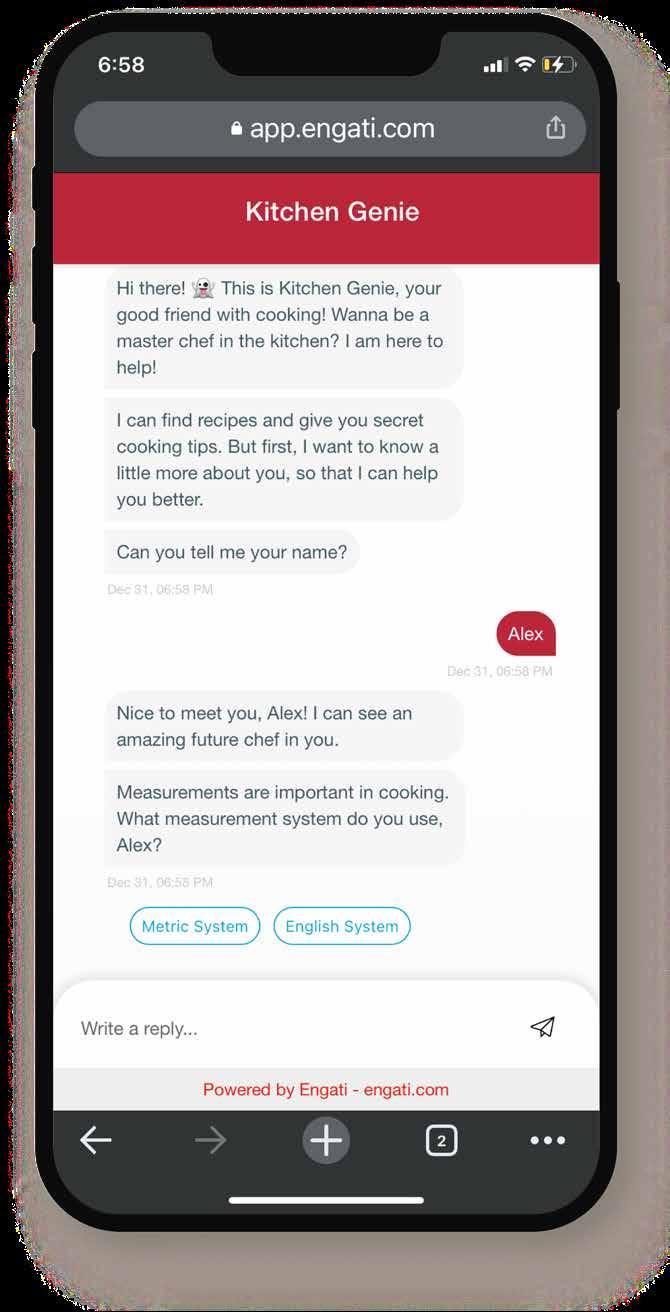


The script was designed in Engati:



28 06 KITCHEN GENIE































































































































